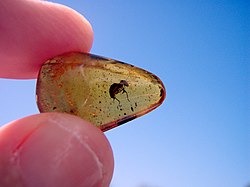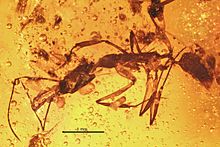Dominican amber

Dominican amber is amber from the Dominican Republic. Resin from the extinct tree Hymenaea protera is the source of Dominican amber and probably of most amber found in the tropics.
Dominican amber differentiates itself from Baltic amber by being nearly always transparent, and it has a higher number of fossil inclusions. This has enabled the detailed reconstruction of the ecosystem of a long-vanished tropical forest.[1]
Age
A study in the early 1990s returned a date up to 40 million years old.[2] However, according to Poinar,[1] Dominican amber dates from Oligocene to Miocene, thus about 25 million years old. The oldest, and hardest of this amber comes from the mountain region north of Santiago. The La Cumbre, La Toca, Palo Quemado, La Bucara, and Los Cacaos mining sites in the Cordillera Septentrional not far from Santiago.[3] Amber has also been found in the south-eastern Bayaguana/Sabana de la Mar area. There is also subfossil copal found in the Cotui deposits with an age of less than 280 years.[4]
Mining sites
There are three main sites in the Dominican Republic where amber is found: La Cordillera Septentrional, in the north, and Bayaguana and Sabana de la Mar, in the east. In the northern area, the amber-bearing unit is formed of clastic rocks, washed down with sandstone fragments and other sediments that accumulated in a deltaic environment, even in water of some depth.[5][6][7]
In the eastern area, the amber is found in a sediment formation of organic-rich laminated sand, sandy clay, intercalated lignite, and as well as some solvated beds of gravel and calcarenite.[8]
Both areas seem to have been part of the same sedimentary basin but were later disrupted by movements along major faults.[9]
Mining
Dominican amber, especially Dominican blue amber, is mined through bell pitting, which is extremely dangerous. The bell pit is basically a foxhole dug with whatever tools are available. Machetes do the start, some shovels, picks and hammers may participate eventually. The pit itself goes as deep or safe as possible, sometimes vertical, sometimes horizontal, but never level. It snakes into hill sides, drops away, joins up with others, goes straight up and pops out elsewhere. 'Foxhole' applies indeed: rarely are the pits large enough to stand in, and then only at the entrance. Miners crawl around on their knees using short-handled picks, shovels and machetes.
There are little to no safety measures. A pillar or so may hold back the ceiling from time to time but only if the area has previously collapsed. Candles are the only source of light. Humidity inside the mines is at 100%. Since the holes are situated high on mountainsides and deep inside said mountains, the temperature is cool and bearable, but after several hours the air becomes stale. During rain the mines are forced to close. The holes fill up quickly with water, and there is little point in pumping it out again (although sometimes this is done) because the unsecured walls may crumble.[10]
Variations
Dominican amber can be found in many colors, besides the obvious amber. Yellow and honey colored are fairly common. There is also red and green in smaller quantities and the rare blue amber (fluorescent).[11][12]
The blue amber reportedly is found mostly in Palo Quemado mine south from La Cumbre.
The Museo del Ambar Dominicano, in Puerto Plata, as well as the Amber World Museum in Santo Domingo have collections of amber specimens.
Paleobiology
Numerous organisms have been described from amber specimens including:


Protozoans
Flora
Fauna
- Acanthostichus hispaniolicus[16]
- Anelaphus velteni
- Anochetus ambiguus[17]
- Anochetus brevidentatus[18]
- Anochetus conisquamis[17]
- Anochetus corayi [19]
- Anochetus dubius[17]
- Anochetus exstinctus[17]
- Anochetus intermedius[17]
- Anochetus lucidus[17]
- Apterostigma electropilosum[20]
- Apterostigma eowilsoni[20]
- Araneagryllus
- Augochlora leptoloba
- Azteca alpha[21]
- Azteca eumeces[21]
- Dicromantispa electromexicana[22]
- Dicromantispa moronei[22]
- Eickwortapis
- Electromyrmococcus[23]
- Elaphidion inclusum
- Elaphidion tocanum
- Formicodiplogaster myrmenema[24]
- Leptofoenus pittfieldae
- Lutzomyia adiketis[25]
- Neocorynura electra
- Nesagapostemon
- Odontomachus pseudobauri[17]
- Odontomachus spinifer[17]
- Oligochlora
- Palaeoplethodon
- Plectromerus grimaldii
- Plectromerus tertiarius
- Pterolophosoma otiliae
- Sphaerodactylus dommeli[26]
- Stizocera evanescens
- Syndesus ambericus [27]
- Tainosia[28]
- Termitaradus mitnicki
- Triatoma dominicana
See also
References
- ^ a b George Poinar, Jr. and Roberta Poinar, 1999. The Amber Forest: A Reconstruction of a Vanished World, (Princeton University Press) ISBN 0-691-02888-5
- ^ Browne, Malcolm W. (1992-09-25). "40-Million-Year-Old Extinct Bee Yields Oldest Genetic Material". New York Times. Retrieved 2008-04-15.
- ^ Corday, Alec (2006). "Dominican Amber Mines: The Definitive List". The Blue Amber Blog. Archived from the original on 2008-04-20. Retrieved 2008-04-15.
{{cite web}}: Unknown parameter|deadurl=ignored (|url-status=suggested) (help) - ^ Schlee, D. (1984): Notizen über einige Bernsteine und Kopale aus aller Welt. Stuttgarter Beitr. Naturk. Ser. C, 18: 29-47, page 35
- ^ Leif Brost and Ake Dahlstrom. The Amber Book, Geoscience Press, Inc., Tucson , AZ, 1996 ISBN 0-945005-23-7
- ^ Wilfred Wichard und Wolfgang Weitschat: Im Bernsteinwald. - Gerstenberg Verlag, Hildesheim, 2004, ISBN 3-8067-2551-9
- ^ Baroni Urbani, C. & Saunders, J.B. (1980): The fauna of the Dominican Republic amber: the present status of knowledge. – Memorias, 9a geologica del Caribe, 1: 213-223; Santo Domingo. (Published 1983).
- ^ Schlee, D. (1984): Besonderheiten des Dominikanischen Bernsteins. – Stuttgarter Beitr. Naturk., C, 18: 63-71; Stuttgart.
- ^ Manuel A. Iturralde-Vennet 2001. Geology of the Amber-Bearing Deposits of the Greater Antilles. Caribbean Journal of Science, Vol. 00, No. 0, 141-167, 2001
- ^ Martínez, R. & Schlee, D. (1984): Die Dominikanischen Bernsteinminen der Nordkordillera, speziell auch aus der Sicht der Werkstaetten. – Stuttgarter Beitr. Naturk., C, 18: 79-84; Stuttgart.
- ^ Schlee, D. (1980): Bernstein-Raritaeten (Farben, Strukturen, Fossilen, Handwerk). – 88 S. (mit 55 Farbtafeln); Staatl. Museum für Naturkunde Stuttgart.
- ^ L. Linati and D. Sacchi, V. Bellani, E. Giulotto (2005). "The origin of the blue fluorescence in Dominican amber". J. Appl. Phys. 97: 016101. doi:10.1063/1.1829395.
{{cite journal}}: CS1 maint: multiple names: authors list (link) - ^ Poinar, G. (2014). "Evolutionary history of terrestrial pathogens and endoparasites as revealed in fossils and subfossils". Advances in Biology. 2014: 1–29. doi:10.1155/2014/181353.
{{cite journal}}: CS1 maint: unflagged free DOI (link) - ^ Poinar, G. (2005). "Triatoma dominicana sp. n. (Hemiptera: Reduviidae: Triatominae), and Trypanosoma antiquus sp. n. (Stercoraria: Trypanosomatidae), the First Fossil Evidence of a Triatomine-Trypanosomatid Vector Association". Vector-Borne and Zoonotic Diseases. 5 (1): 72–81. doi:10.1089/vbz.2005.5.72. PMID 15815152.
- ^ Ancient Termite Pollinator of Milkweed Flowers in Dominican Amber Poinar GO Jr. American Entomologist 2017 63:52-59
- ^ De Andrade, M. L. (1998). "First description of fossil Acanthostichus from Dominican amber (Hymenoptera: Formicidae)". Mitteilungen der Schweizerischen Entomologischen Gesellschaft. 71: 269–274.
- ^ a b c d e f g h De Andrade, M. L. (1994). "Fossil Odontomachiti Ants from the Dominican Republic (Amber Collection Stuttgart: Hymenoptera, Formicidae. VII: Odontomachiti)". Stuttgarter Beiträge zur Naturkunde. Serie B (Geologie und Paläontologie). 199: 1–28.
- ^ MacKay, W. P. (1991). "Anochetus brevidentatus, new species, a second fossil Odontomachiti ant (Hymenoptera: Formicidae)". Journal of the New York Entomological Society. 99: 138–140.
- ^ Baroni Urbani, C. (1980). "Anochetus corayi n. sp., the first fossil Odontomachiti ant. (Amber Collection Stuttgart: Hymenoptera, Formicidae. II: Odontomachiti)". Stuttgarter Beiträge zur Naturkunde. Serie B (Geologie und Paläontologie). 55: 1–6.
- ^ a b Schultz, T.R. (2007). "The fungus-growing ant genus Apterostigma in Dominican amber". Memoirs of the American Entomological Institute. 80: 425–436.
- ^ a b Wilson, E.O. (1985). "Ants of the Dominican amber (Hymenoptera: Formicidae). 3. The subfamily Dolichoderinae". Psyche. 92: 17–37. doi:10.1155/1985/20969.
{{cite journal}}: CS1 maint: unflagged free DOI (link) - ^ a b Engel, MS; Grimaldi, DA (2007). "The neuropterid fauna of Dominican and Mexican amber (Neuropterida, Megaloptera, Neuroptera)". American Museum Novitates. 3587: 1–58. doi:10.1206/0003-0082(2007)3587[1:TNFODA]2.0.CO;2.
- ^ Johnson, M.S.; et al. (2001). "Acropyga and Azteca Ants (Hymenoptera: Formicidae) with Scale Insects (Sternorrhyncha: Coccoidea): 20 Million Years of Intimate Symbiosis". American Museum Novitates. 3335: 1–18. doi:10.1206/0003-0082(2001)335<0001:AAAAHF>2.0.CO;2.
- ^ Poinar, G.O. (2011). "The Evolutionary History of Nematodes: As Revealed in Stone, Amber and Mummies". Nematology monographs and perspectives pages. 9: 91–93, 239–240, 324–325.
- ^ Poinar, G. (2008). "Lutzomyia adiketis sp. n. (Diptera: Phlebotomidae), a vector of Paleoleishmania neotropicum sp. n. (Kinetoplastida: Trypanosomatidae) in Dominican amber". Parasites & Vectors. 1 (1): 22. doi:10.1186/1756-3305-1-22. PMC 2491605. PMID 18627624.
{{cite journal}}: CS1 maint: unflagged free DOI (link) - ^ Daza, Juan Diego; Bauer, A. M.; Wagner, P.; Böhme, W. (Jan 1, 2012 (26 Sep 2012 online)). "A reconsideration of Sphaerodactylus dommeli Böhme, 1984 (Squamata: Gekkota: Sphaerodactylidae), a Miocene lizard in amber". Journal of Zoological Systematics and Evolutionary Research. Wiley Online Library. doi:10.1111/jzs.12001. ISSN 1439-0469.
Subsequent to the acceptance of this paper, we obtained high resolution X-ray computed tomography imagery for the paratype of Sphaerodactylus dommeli that confirms that it is correctly allocated to genus. Details of its osteology will be reported elsewhere.
{{cite journal}}: Check date values in:|date=(help) - ^ Woodruff, R.E. (2009). "A new fossil species of stag beetle from Dominican Republic amber, with Australasian connections (Coleoptera: Lucanidae)". Insecta Mundi. 0098: 1–10.
- ^ Szwedo, J.; Stroiński, A. (2001). "Tainosia quisqueyae gen. and sp. nov. from the Oligocene/Miocene Dominican amber (Hemiptera: Fulgoroidea: Nogodinidae)" (PDF). Genus. 12 (1): 29–34.
External links
- Ambarazul.com: The Definitive List of Dominican Blue Amber Mines
- Palaeo.uk: "Geological setting and age of the Dominican Republic" — by Christine Lipkin.
- PBS NOVA: "Amber: Jewel of the Earth"
- ISEM Research: Anolis lizard in amber
- American Museum of Natural History: "Amber: Window to the Past" (1998)
- Emporia.edu: Life in Amber — includes numerous other links.
Dominican amber.
